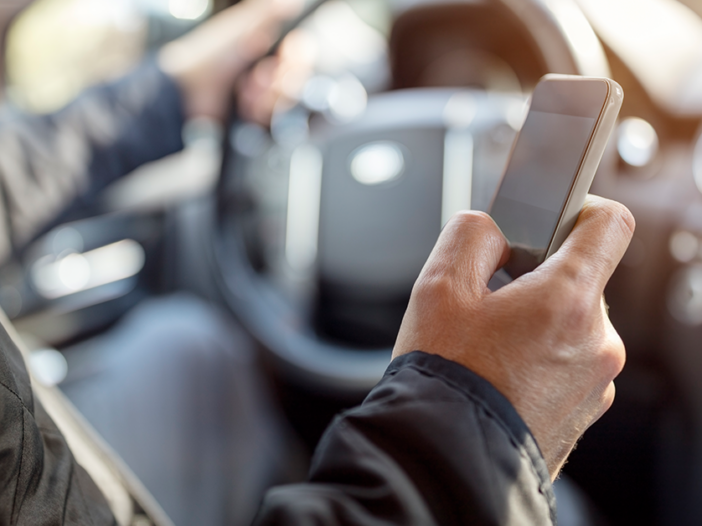
A deeper dive into distracted driving: stats and tips on how NOT to be a stat
Distracted driving is a factor in 80 percent of crashes, says the National Highway Traffic Safety Administration (NHTSA). This issue of driver distractions is not only increasing auto accidents and raising personal auto rates – it’s also an increasing fleet safety issue, impacting commercial auto rates.
We’ve all honked our horns at the driver in front of us texting, causing us to nearly miss a green light. Or the driver slightly weaving as she tries to text and drive at the same time. But distracted driving isn’t just talking on a cell phone while driving.
In its broader form, distracted driving is any driver inattention where he or she is delayed in identifying or recognizing road conditions or information needed for safe driving due to an activity, event, object or person within or outside of the vehicle that interferes with the driver’s attention to the road.
Related: How to combat spiking commercial auto claims
Drivers engage in potentially distracting secondary tasks approximately 30 percent of the time their vehicles are in motion, according to an NHTSA report. Conversation with passengers is the most frequent secondary task. According to an article from The Hartford, other distractions include:
- Talking or texting on a cell phone
- Eating and reading
- Manipulating controls such as the radio, GPS or air temperature
- Navigation and hand-held computers or devices
- Smoking
- Route problems – looking for route and/or traffic signs
- Unfamiliar situations such as staring at an automobile crash
Should you enact a policy of no cell phone use while driving?
Here’s how a number of safety organizations weigh in on cell phones and distracted driving:
The National Highway Traffic Safety Administration’s policy states, “The primary responsibility of the driver is to operate a motor vehicle safely. The task of driving requires full attention and focus. Cell phone use can distract drivers from this task, risking harm to themselves and others. Therefore, the safest course of action is to refrain from using a cell phone while driving.”
The National Safety Council Distracted Driving policy includes this statement: “When driving on personal time or company business, NSC employees may not use cell phones (including hands free) or any other mobile electronic devices while operating a motor vehicle. This includes, but is not limited to, answering or making phone calls, engaging in phone conversations, reading or responding to e-mails and text messages, adjusting a Global Positioning System (GPS) and accessing the Internet.”
The Council’s Position/Policy Statement says, “Distraction is a danger to all roadway users. Distraction caused by talking on the phone, browsing the internet, using apps, texting, and use of other electronic devices while driving puts all roadway users at risk. The National Safety Council (NSC) supports laws banning the use of electronic devices while driving. Drivers should also avoid other activity that takes a driver’s eyes and mind off the task of driving.”
Related: Distracted driving prevention: How NOT to be a statistic
More distracted driving facts to share with your employees
In case your commercial insurance client is on the fence about the importance of a zero distracted driving policy, here are a few statistics to share with them:
- Drivers who use cell phones are four times more likely to be involved in a crash. (Insurance Institute for Highway Safety)
- Cell phone use is attributed to an estimated six percent of all crashes, which equates to 636,000 crashes, 330,000 injuries, 12,000 serious injuries and 2,600 deaths each year. (Harvard Center for Risk Analysis)
- No difference exists in cognitive distraction between handheld and hands-free devices. Research shows that driving while using a cell phone can pose serious cognitive distraction and degrade driver performance. (NHTSA)
- 80 percent of crashes are related to driver inattention. The number one source of driver inattention is cell phones. (Virginia Tech 100-car study produced for the National Highway Traffic Safety Administration)
- The annual cost of crashes caused by cell phone use is estimated at $43 billion. (Harvard Center for Risk Analysis)
- Talking to a passenger while driving is significantly safer than talking on a cell phone. (University of Utah study)
- The National Safety Council polled 2,000 members about employee use of wireless communication devices. They found that 469 companies prohibit both handheld and hands-free devices while driving for some or all employees. Nearly all – 99 percent – said this policy did not decrease productivity.
Related: Safe driving management tips to reduce your risk
Website resources:
- The Zero Fatalities website provides additional information on distracted driving.
- The National Safety Council provides a free Cell Phone Policy Kit. It contains information on employer policies, cell phone fact sheet, sample employee policy, key research studies and more.
- State laws on cell phone use and text messaging may be obtained from the Insurance Institute for Highway Safety website.
Consider this: One of your employees distracted while driving for their job may cause personal tragedy for them and others involved in a collision, as well as potential financial circumstances for you, their employer.
This article originally appeared on Arrowhead’s corporate website. It has been updated and modified to better fit the needs of our Tribal producers and their insurance clients.
